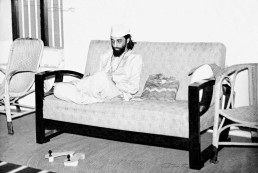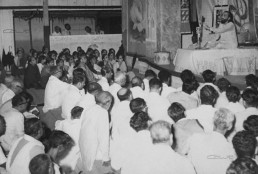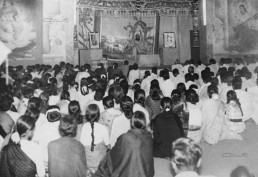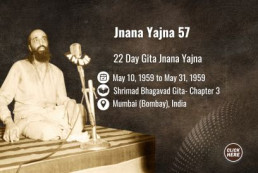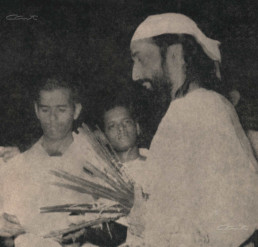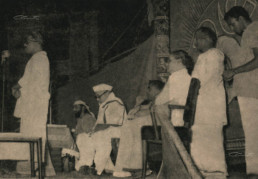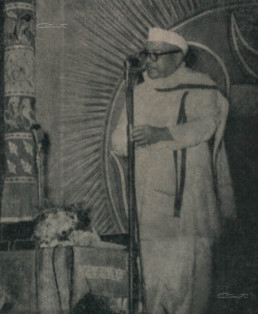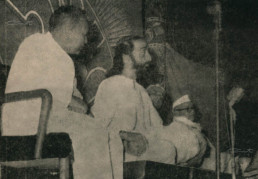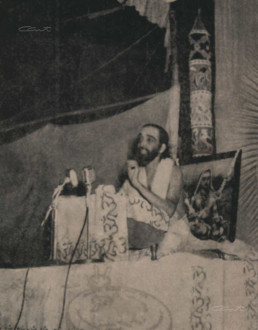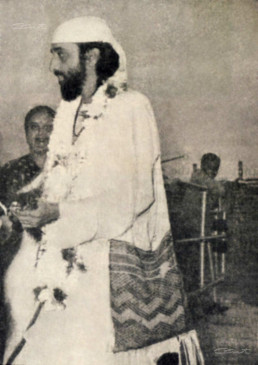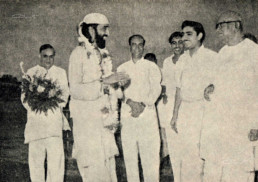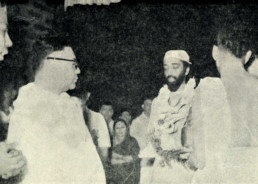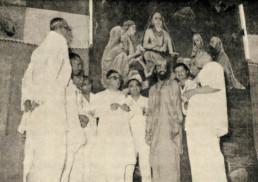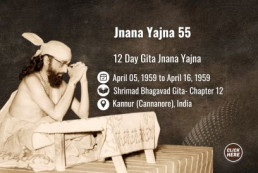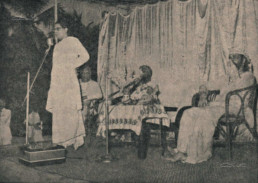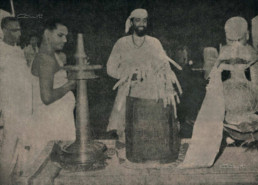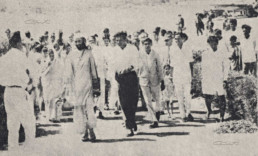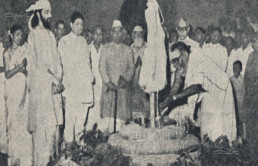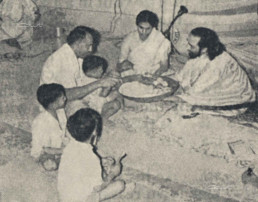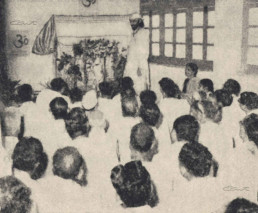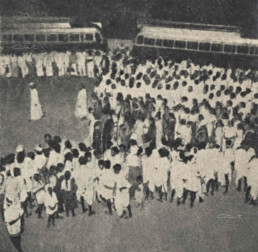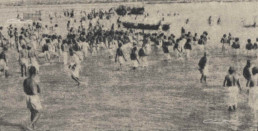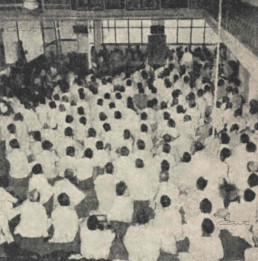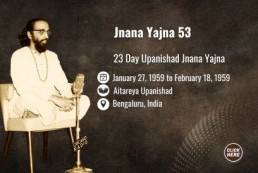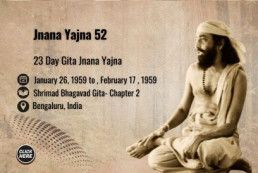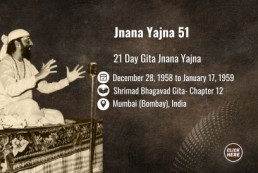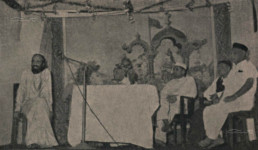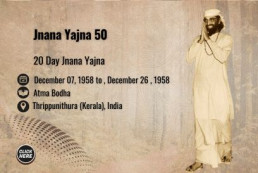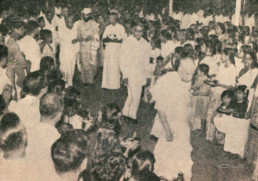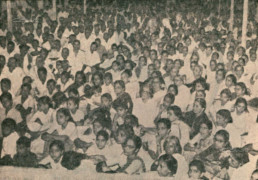Jnana Yajna 58

Jnana Yajna 58

Year & Dates:
June 07, 1959 to June 28, 1959

Yajna Topic:
Shrimad Bhagavad Gita- Chapter 15

Place:
Coimbatore, India.
“I discovered the relationship existing between things, but I do not know Who put this relationship into the world.” Thus wondered the theoretical physicist, Albert Einstein, when congratulated for his outstanding scientific achievement in relativity and quantum physics. The sages who studied the Who, its manifestation as the world and the individual, had that Knowledge revealed in their deep study of life and white heat of meditation. That Knowledge Bhagavan Krishna gave in its succinct form as Shrimad Bhagavad Gita, and Pujya Gurudev unlocked its invaluable pages to reveal its great significance for the present: “I am interested in today, now, and not in a postmortem gain. The most important thing to be known of life is – how I am to live in this world, a better, more intelligent, and happy man in this very birth. Today, even with everything at his door, man’s intellect still questions if this is all, and Religion has an answer to this query.”
Enquiry about the Infinite
The venue chosen for the 58th Jnana Yajna in Coimbatore was a palatial hall of a Kalyana Mandap (marriage hall). On the evening of June 7, 1959, the hoisted Om flag signaled that the beautiful hall had acquired a spiritual hue as Pujya Gurudev’s yajnashala. Sri Baburam Saxenner, a Sanskrit scholar and professor of the Allahabad University inaugurated the yajna, and Sri Venkataswami Naidu welcomed the honored guests and Pujya Gurudev. In that packed hall, Pujya Gurudev first clarified the role of religion and philosophy in nation-building: “World is a teamwork, a single event may be the result of infinite causes. And in this universal teamwork, if we do not know how to play the game of life, we will only kick and quarrel and ruin ourselves. Gita tells us our propositions, how they come, and how we must meet them and eke out of them maximum benefit and happiness. But to understand Gita, we must first come to understand the theme of life as such. Now while talking on Gita, I am giving you only suggestions. So, don’t accept them immediately, but independently think and then only come to any conclusion.”
In the morning classes, His richly illustrative Atma Bodha fostered the spirit of enquiry. Pujya Gurudev then unfolded the glory of the Highest Purushottama, the Truth Supreme, knowing which seekers gain real independence from all sorrows of the body, mind, and intellect.
In the Coimbatore Yajna, the other sadhana features of Akhanda Kirtana, Laksharchana, or Havana could not be completed because of an unforeseen time constraint. Nevertheless, the divine vibrations that Pujya Gurudev created through His discourses were powerful enough to keep the aspirants steadfast in their spiritual quest.
Photo Gallery

“Think,” Says Pujya Gurudev
With reference to the perishable, finite, world of constant change, the Spirit is defined there in the Chapter as the imperishable, Infinite, Changeless Factor, which is at once the substratum and the nourishment for the imperfect world-of-plurality. The Infinite is thus defined as the imperishable (Akshara) with reference to the perishable (Kshara) equipment of matter. After thus indicating the antithesis of change as changeless he will explain how the experiencer of the changes, being Infinite, is even something other than that which we know as the change and the changeless. This Unconditioned Eternal Factor, is called by the Geeta as the Purushottam.
From Tyagi Magazine
Your only Greatest Enemy!
In this enlightening discourse, Swamiji reveals the insidious nature of Maana (pride) and Moha (vanity), showing how they can become formidable obstacles on the path to self-realization. Discover how to recognize and overcome these inner enemies, leading to true freedom and spiritual awakening.
Jnana Yajna 57
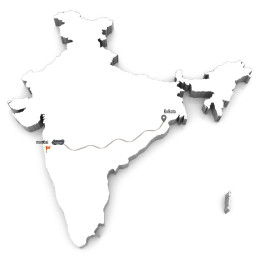
Jnana Yajna 57

Year & Dates:
May 10, 1959 to May 31, 1959

Yajna Topic:
Shrimad Bhagavad Gita- Chapter 3

Place:
Mumbai (Bombay), India.
It was a strange spectacle for 21 days, a puzzling combination of festivity and silence, of fervent prayers and deep introspection. With an unusual stamina, the work-weary and fashionably secular people of Mumbai hurried into Matunga’s Gymkhana Grounds every evening from May 10, 1959, by trains, trams, and other transport. They forgot the hardship of sitting on a hard ground for two hours. The charismatic Master of Gita had their minds in His reins. The magic began from the first moments of a vibrant inauguration on May 10th. A delightful array of sweet little children from the nearby orphanage, dancing with their batons to the rhythm of the drums and cymbals, led a joyful procession with Pujya Gurudev walking to the orange-canopied yajnashala. With the traditional Purnakumbha welcome, the fluttering Om Flag, and the holy Gangajal pots that arrived with Pujya Gurudev, the start was sanctified.
Dramatic Touch, Dedicated Actions
The 57th Jnana Yajna was a labor of love collectively organized by the Dadar, Matunga, and Sion localities of Mumbai. The eminent Sri Ananthasayanam Iyengar, Speaker of the Lok Sabha, on inaugurating the yajna, prefaced that the chapter 3 of the Gita was “dedicated to the philosophy of action, which is the topic for today’s turmoil’s and failures of man. Our present condition is similar to Arjuna’s despair, of retreating when action is necessary.” To educate the huge gathering over 7000 of mixed aptitudes, Pujya Gurudev brought out the nuances of the path of action as expounded in the third chapter, Karma Yoga of the Gita. Powerful in its flow like the vigorous Ganga, His words swirled through the audience who wondered and pondered about duties that uplifted life.
The 6:30 am morning classes on Atma Bodha drew about a thousand spiritually thirsty aspirants; to encourage them to memorize and recite the poetic 68 verses, a prize was announced to be awarded when the yajna ended. Additionally, each evening between 7 pm and 7:50 pm, Sri T. Seshadri (whom Pujya Gurudev called “His Tamil mouth!”) translated the previous evening’s discourse for the Tamil-speaking public, and Sri Natarajan, the Editor of “Tyagi” chanted the slokas of the third chapter.
To bolster introspection with spiritual sadhana, the daylong Vishnu Laksharchana from 7 am until 5 pm on May 23rd in the Jain Boarding Hall was a heavenly experience. The idol of Bhagavan Vishnu which glowed more with each arati after every round of chanting the Vishnu Sahasranama, the fragrant flowers and incense, the ardent devotees, and the inspiring presence of Pujya Gurudev in that hall – every aspect sparked the highest sense of worship.
A unique feature of the 57th yajna was a memorable 4-scene drama staged by the ex-students of the Dramatic Club on the story of the immortal devotee, Markandeya. Pujya Gurudev ensured all children aged 12 and under got front row seats to the well-enacted play.
In the Guru Dakshina ceremony on May 29th, Pujya Gurudev handed the yajna prasad of ‘Japa Yoga and Gayatri.’ Every action in that 57th Jnana Yajna was performed with Grace and surrender.
Photo Gallery

“Think,” Says Pujya Gurudev
It is obvious that the productivity that is dormant in any situation can be invoked only by man’s sincere efforts. This potential which generally lies dormant everywhere is the Deva to be cherished by the worker through the Yajna activities, and certainly, it is sure that the Deva will manifest in turn to cherish or to bless the worker. “Thus cherishing one another, man shall gain the highest good,” is the Divine intention, in the mind of the creator, says Krishna in this stanza.
This Law of Seva is faithfully followed by every sentient and insentient member of the cosmos instinctively. Man alone is given the freedom to act as he likes and to the extent he disobeys this Universal Law of Sacrifice, Yajna, to that extent he comes to suffer, not because there are no joy content in things and situations, but because he with his arrogant and egoistic actions bring a discord in the harmony of the existence around him.
From Tyagi Magazine
“Rain” is the necessary condition for the conversion of the mineral raw material into enjoyable and nutritive food in life. Similarly, in all fields of activity there is “an enjoyable profit” which can be gathered only when the field comes under conditions favorable for it to produce those profits. “Self-dedicated activities” (Yajna) when performed in any given field of endeavor, will be creating therein “Conditions necessary for the field to smile forth” (rain) in a luxurious “crop of profit” (Annam) enjoyable by the society.
For example-the wasteful waters of a river flowing idly can be dammed and made use of for protecting agriculture if the waters are intelligently employed in irrigating the fertile lands now lying fallow on its banks. Through sacrifice and work alone can the dam be built and when it is built, it provides “conditions helpful” (rain) for bringing the lands on either side under the plough. Again, making use of the irrigated land man is yet to strive: ploughing, sowing, weeding, waiting, gathering; before he can to enjoy the profit of his activities, the food.
We are shown how this Wheel-of -Action is connected with and includes the Supreme. The principle of right action has come out of the Creator himself and the Creator is none other than the Imperishable Supreme. Therefore, the All-pervading Supreme is ever centered in all undertakings pursued in an honest spirit of Self-dedication for the good of all.
From Tyagi Magazine
Is the Rat Race everything?
Can work become a path to self discovery? With humor and wisdom, Swamiji reveals how work, when performed with mindfulness and awareness, can become a handmaiden for spiritual progress.
Jnana Yajna 56
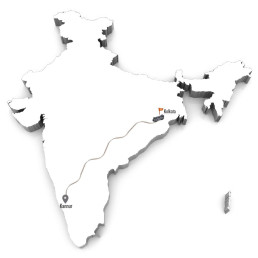
Jnana Yajna 56

Year & Dates:
April 19, 1959 to May 08, 1959

Yajna Topic:
Kenopanishad

Place:
Kolkata (Calcutta), India.
Even the sheets of rain storm that inundated Kolkata on the opening day of the 56th Jnana Yajna became the ideal backdrop for vichara (contemplation) in Pujya Gurudev’s perspective. After the president of the yajna committee, Hon’ble Justice P. B. Mukharji inaugurated the Jnana Yajna on Kenopanishad, Pujya Gurudev pointed out how the storms of life spark the search within. He talked about the crucial difference between the points of view of materialists and the ancient sages. He used the analogy of a ripple that arises when a stone is tossed on a calm lake – from the center, the ripple naturally expands outward in concentric circles. Conversely, a materialist attempts an unnatural reverse order hoping to converge at the center of happiness. While a materialist tries to keep rearranging the outside world, the sages declare: “Improve the man to improve the world.”
The Untiring Journey Within
Pujya Gurudev brought the attention of the Kolkata audience who braved the storm to the analysis of Kenopanishad. In the three weeks of discourses, He encouraged all seekers to focus on the core that energizes the ripples of life’s activities. In that fourth yajna at Kolkata, the admirable consistency of Pujya Gurudev shone through. It took one back to 1951, to His introduction to Kenopanishad in the very first yajna. Pujya Gurudev had narrated the way Chinmaya pointed the rising sliver of the crescent Moon to His companions on a bright cloudless sky. He had systematically guided the attention of the companions first to a mango tree nearby, then to its branch arching north, to the two leaves nodding in the breeze, carefully nudging their vision to look between the leaves, and finally up at the beautiful crescent in the sky.
Using that proven way of Brahma Vidya to turn within and then ‘see the Unseen,’ Pujya Gurudev systematically prepared the audience of Kolkata to turn their vision from yonder to within – to the Truth, the Indescribable Self.
The frequency of yajnas across cities was increasing; Pujya Gurudev’s schedule was tight. He had traveled all the way from the 55th Jnana Yajna at Kannur in Kerala to the 56th yajna in Kolkata, West Bengal. But the miles of travel had no hold on Him. His energy had a transcendental source, and it was His incredible persistence that enabled people to strive for that crucial “about-turn” in vision.
Photo Gallery

“Think,” Says Pujya Gurudev
But we in our preoccupations with life refuse to look into the within, the Centre of Light – the Light of Truth – but fix our gaze ever outwards! We attach much value to things material, gross, and physical. We miss the Divine Spark and see only the reflected beam! We applaud a modern scientist, a Western Psychologist, who has thrown some light as to the secrets of the psychical elements or the superficial human characteristics. If reflected light can give so much of glory, then what would be the condition and glory of one who is the very embodiment of Truth, THE CENTRE OF THE CENTRE?
From Kenopanishad Yajna Prasad
Don’t be a Slave!
Pujya Gurudev Swami Chinmayananda brings the wisdom of Kenopanishad to life with humor and relatable anecdotes. Through the analogy of the owner and the vehicle, Swamiji explores the pitfalls of attachment and blind fascination. Discover how to break free from enslavement to worldly possessions and uncover the true master within.
Jnana Yajna 55
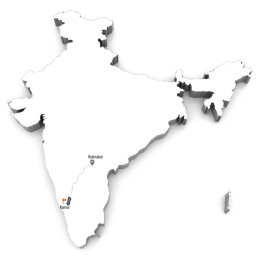
Jnana Yajna 55

Year & Dates:
April 05, 1959 to April 16, 1959

Yajna Topic:
Shrimad Bhagavad Gita- Chapter 12

Place:
Kannur (Cannanore), India.
A historic seaport along the Malabar coast of northern Kerala, Kannur (known earlier as Cannanore) is a picturesque town also famous for its weaving industry and pristine beaches. There, on the evening of April 5, 1959, at the Sundareshwara temple, Pujya Gurudev was given a traditional, Kerala-themed welcome by Shri Haridas Govardhandas, the president of the yajna committee. The 11-day, 55th Jnana Yajna was inaugurated by Sri V. M. Nair, Editor of Mathrubhumi, a widely read newspaper of Kerala. Pujya Gurudev chose to share the message of devotion, focusing on Shrimad Bhagavad Gita’s chapter 12, Bhakti Yoga, in that Jnana Yajna. In His introduction, He analyzed how despite the growing comforts in life, the problems that plague mankind cannot be “correctly diagnosed and treated” using only the narrow field of vision of politicians, economists, or scientists.
Gita Distilled and Delivered
Pujya Gurudev’s treatment through His Gita Jnana Yajnas was systematic so that the solutions could be long-acting. And, the 700 verses of Gita were the distilled essence apt for the many-faced Arjuna disease in the modern world. But first, the powerful remedy had to be brought from the decorated altar in puja rooms into the living spaces to heal and strengthen. Pujya Gurudev was facilitating that with keen estimation and consistent patience, choosing carefully the right chapter for each town or city.
For the quaint and small Kannur, in that brief Jnana Yajna, Pujya Gurudev chose Chapter 12, Bhakti Yoga. Over a thousand people gathered every evening in the yajnashala erected within the temple, careful not to miss Pujya Gurudev’s thought flow. Mindful that their questions were similar to what Arjuna asked, Pujya Gurudev explained the obstacles that arose when trying to attune the mind to an unmanifest Supreme Principle. Then what should be the way to worship a God with a form? Is a seeker who builds equipoise through detachment and meditates on the Infinite a better devotee? Clearly and thoroughly, the path of devotion and the promise of Bhagavan that a steadfast devotee undoubtedly reaches Him was laid out; When the earnest audience of Kannur heard Pujya Gurudev enumerate the thirty-six magnanimous qualities of a perfect devotee who is very dear to Bhagavan, they were deeply inspired.
Though only for eleven days, the 55th Jnana Yajna made an indelible mark on the psyche of Kannur, endowing the people with the faith that Gita is a divine panacea.
Photo Gallery

“Think,” Says Pujya Gurudev
Generally there is a feeling that the Path of devotion is a very easy and simple way for self-perfection. In fact no path is easy. It is equally true to say that no chosen path is difficult for the seeker who has chosen it. Paths are different only because of the vehicles employed: in a boat we can never travel on the grand trunk road, nor can we in a plane sail over the waves, nor on a cycle dash at 60 miles an hour! There are limitations for each vehicle. But in all of them progress is assured to the intelligent and the careful. Similarly, for self-development each type of seekers according to the vehicle available with them choose either the Path of Devotion or the Path of Action or the Path of Knowledge. To each one of them his Path is the easiest.
From Tyagi Magazine
That intelligent relationship maintained by seeker towards the world outside whereby experiences in himself a uniform steadiness in himself, in spite of the mad revelry of things and beings around him, is called the condition of equanimity. One who has developed the right sense of discrimination can easily watch for and see the golden chord of Beauty that holds together all that is enchanting and grotesque in the world outside. This capacity is called Samabuddhi.
From Tyagi Magazine
Which Spiritual Path is right for you?
Bhagavan Shri Krishna suggests alternative spiritual paths according to our inclination and aspiration. Whether through devotion, practice, action, or renunciation, discover the path that resonates with you on your journey to self-realization.
Jnana Yajna 54
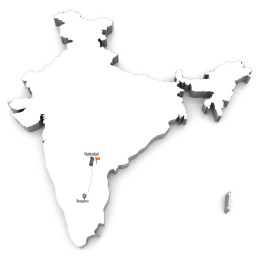
Jnana Yajna 54

Year & Dates:
February 22, 1959 to March 24, 1959

Yajna Topic:
Kathopanishad

Place:
Hyderabad, India.
The symbol of a new spiritual awakening during a time when India shortchanged her spiritual vitality for material advancement – This was how Pujya Gurudev was welcomed by the Hyderabad Yajna committee president, Shri Daulat Rai on the evening of February 22, 1959, in the spacious Sarojini Devi Hall. And, in His inaugural address, Shri Thimma Reddy, Minister for Agriculture, added that India needed wise, sagely guidance to safeguard her recent independence and recapture her old glory. Pujya Gurudev began the 54th Jnana Yajna with a caution: “The responsibility of reviving our cultural heritage should not lie on the shoulders of the sannyasins and the mahatmas alone. It should be equally shared by one and all, and each one of us should pledge ourselves to this noble cause of rediscovering our own past glory. Such a thing can be brought about not by ascertaining our rights but by accepting our duties.”
Pledging Spiritual Revival
The concluding words of the Chinmaya Mission Pledge echoes how true revival is an individual and shared journey – “ We know our responsibilities. Give us the ability and courage to fulfill them.” Pujya Gurudev brought to the forefront how India’s ancient rishis had given the human race, through the upanishadic revelations, the know-how and ability to build an integrated life. And, with every Jnana Yajna, Pujya Gurudev kept reinforcing both the goal and the way. In Hyderabad, it was the unparalleled Kathopanishad that would illustrate the narrow path to expansive happiness.
It is an upanishad that tugs at the heart speaking to the Nachiketa that we all aspire to be. No wonder, the yajnashala couldn’t hold the crowds that rushed in even at 5 pm to find a place in front of Pujya Gurudev who strode in like a spiritual colossus at 6:30 pm. His words, expressions, jokes, warnings, and blinding clarity etched the verses of Kathopanishad in those ready hearts.
On the Sunday of March 14th, Pujya Gurudev arranged a magnificent Vishnu Sahasranama Laksharchana.The daylong worship before a lustrous murti of Vishnu with continuous archana with beautiful flowers, fervent chanting, and many aratis transported everyone to the glorious realm of blissful Bhakti.
A truly spiritual bonanza, Pujya Gurudev elaborated on the glory of Gita’s Bhakti Yoga, Chapter 12, in the Balaji Bhavan Hall from 8 am to 9 am. Finishing that, He taught Aitareya Upanishad. From March 16th, He delved into Adi Shankara’s melodious five Praatah Smaraami verses. An exceptional feature was when Pujya Gurudev expounded on Viveka Choodamani from March 25th, this time sitting under a tree in the very early dawn. Hundreds gathered for those idyllic discourses. Apart from being bathed in exemplary Vedanta, the Avabhrta snaana on March 22nd in the sacred Krishna river and the divine prayers at the ancient Vedaadri temple was an experience beyond words. The 54th Jnana Yajna of Pujya Gurudev’s gave all the ability to rediscover the many blessings of Bharat.
Photo Gallery

“Think,” Says Pujya Gurudev
This question whether there is existence after death or not is not one which belongs to the Realm of the Mind and the Intellect. These instruments of feeling and knowing do, at their best, give us only some vague directions pointing towards a World of knowledge that actually lies spread out beyond their own frontiers. In order to travel towards that Land of Pure Knowledge the ordinary mortal, however intellectual and sensitive he may be, has not the necessary vehicle. It is only the great Masters of renunciation and wisdom who have specially developed their intuitive faculty that can at will take one into these Realms Beyond.
In short, such transcendental questions cannot be explained by words and established through any of the ordinarily known ‘proofs of knowledge’ such as Direct-perceptions, Inference Comparison etc. The only way to solve them is through the Agamas, which are the words of Wisdom given out by men of greater realization to the saints and Sages.
From Kathopanishad Yajna Prasad
No one can give this to you!
Exploring through this short excerpt the rarity of true understanding between master and student. Through insightful anecdotes and timeless wisdom, Swamiji sheds light on the prerequisites for genuine comprehension and the profound impact of a rare encounter with spiritual truth.
Jnana Yajna 53

Jnana Yajna 53

Year & Dates:
January 27, 1959 to February 18, 1959

Yajna Topic:
Aitareya Upanishad

Place:
Bengaluru, India.
In the sharp cold morning air of January 27, 1959, at the City Institute Grounds of Chamarajpet, Bengaluru, there was a warm glow of happiness inside the pandal where the 53rd Jnana Yajna of Pujya Gurudev was inaugurated at exactly 7:30 am. Before the large, attentive audience who had gathered, Dr. Anantharaman, a respected scientist and professor at Indian Institute of Sciences (IISc), Bengaluru, honored Pujya Gurudev with the title “Vedanta Kesari,” meaning the “Lion of Vedanta” and appreciated how Chinmaya Jnana Yajnas were the apt answer to problems, personal or national.
Beginning with the impassioned Santipath, Pujya Gurudev highlighted how Aitareya, a boy not brahmin by birth, gained the Highest Wisdom and gave it to all as Aitareya Upanishad. This only proved that scriptures welcome sincere aspirants of any background.
The All-Embracing Lion of Vedanta
When introducing the Aitareya Upanishad, Pujya Gurudev narrated how Mother Earth initiated the son of Itara, Mahidasa (a potter and servant of the earth) to realize the Infinite Perfection. He drew attention to the way the Upanishad under study, belonging to Rg Veda, contained “similes and metaphors taken from the potter’s life, and to that extent, we may say that Aitareya Upanishad is the Scripture of the common man, the Bible of the proletarian, the Quran of the laborer.” As He elaborated on the great progression of thought in the Upanishad, the common examples began indicating the lofty Truth behind Creation, the journey of the jiva (individual soul), and the essence of unity declared by the well-known Mahavakya – Prajnanam Brahma, Consciousness is Brahman.
As this Upanishad Jnana Yajna ran parallel with the Gita Jnana Yajna, their paths united in a glorious Akanda Kirtan before a resplendent Krishna Vigraha in the Odakathur Mutt culminating in a grand Vishnu Sahasra Laksharchana. Pujya Gurudev explained how offering flowers in worship symbolized surrendering the negative vasanas (inherent tendencies) to purify and invoke the Divine within.
Always making time for children and youth amid the two Yajnas, Pujya Gurudev was overjoyed to listen to the “Chinmaya Bala Vihar” children of Chamarajpet recite the entire second chapter of the Gita. He also made sure to inspire the youth in various colleges in Bengaluru with His many lectures..
The Avabhrta Snaana at the sacred Kapila river near Nanjundeshwara temple with the bonus darshan at the renowned Chamundeshwari temple was an unforgettable immersion where kirtan, bhajan, meditation, Gita chanting, and satsang with Pujya Gurudev made over 500 devotees temporarily transcend their preoccupations with a mundane world.
The two yajnas were a Vedantic symphony. Pujya Gurudev, as the consummate conductor, made children, youth, and adults of all backgrounds reach a spiritual crescendo through several paths.

“Think,” Says Pujya Gurudev
Memory is facilitated by continuously employing the mind to dwell upon those thoughts for a longer period, and this mental and intellectual process of assimilation of what we have heard is called ‘reflection’ (Manan.) To do manan we need not renounce the world or run away into a quiet corner. It is most effectively undertaken by maintaining in one corner of the mind these thoughts to smolder. A small quantity of incense burning at one end of a hall can impart its fragrance throughout the hall, and even waft the same sweetness to the atmosphere outside the windows. So too, the vedantic discourses heard once may be allowed to smolder at one end of the mind and it will soon spread its fragrance into the wider world of one’s own thoughts and ideas within, and speech and actions without.
From Aitareya Upanishad Yajna Prasad
Is Creativity a Blessing or a Curse?
Uncover the hidden challenges of creativity as Swami Chinmayananda discusses the dangers of excessive identification with our creations. Gain valuable insights into how to embrace creativity while remaining grounded in detachment and self-awareness.
Jnana Yajna 52

Jnana Yajna 52

Year & Dates:
January 26, 1959 to February 17, 1959

Yajna Topic:
Shrimad Bhagavad Gita- Chapter 2

Place:
Bengaluru, India.
The announcement in Cantonment Railway Station, Bengaluru of the arrival of the train carrying the adored and revered Swami Chinmayananda, the elated meet and greet, the traditional reception at the Odakathur Mutt, and the informal satsang before everyone rushed to get ready for the formal inauguration of the 52nd Jnana Yajna on January 26, 1959 – joyfully predictable but ever refreshing was the way Pujya Gurudev’s Jnana Yajnas were welcomed anywhere they were conducted.
For thousands of seekers, time would take a special meaning the minute Pujya Gurudev arrived in the Yajnashala. As the crowds poured in ahead of time into the expansive pandal set up in the middle of the city, the orderliness and serenity that prevailed was and is a thing of wonder.
Extraordinary, Unshakable Harmony
None wanted to miss the majestic entrance of Pujya Gurudev into the overflowing yajnashala at exactly 6 pm with the Elaya Raja of Travancore. The inaugural ceremony progressed smoothly with the energizing Om flag, the respectful welcome, an appreciative inaugural address by the royal dignitary, and the Krishna -Arjuna- Samvaada canvas unveiled.
With His voice that could enter a million hearts at once, Pujya Gurudev invoked the power of Om and began with a metaphoric comparison. Like children who exhaust themselves in the playground, the majority run around the world scorched by life’s demands. And, religion, like the caring mother, watches and waits, ready to refresh the panting and the tired. Pujya Gurudev continued, “Rank materialism will not survive long, and mere spiritualism alone cannot thrive. There must be a harmonious blending – a happy nuptial between the two which alone will pave the way to prosperity and happiness.” Gita is for any age or stage. He emphasized how the second chapter, especially, was a sweeping and practical overview of the perfect science of life.
The second chapter of the Gita is a flight to the Highest, particularly when Pujya Gurudev pilots the learning. From verse to verse, He charted the course with the illuminating words of Bhagavan Krishna. To prepare the physical with selfless action, to purify the emotional with devotion, to educate the intellect with the Supreme Knowledge, and to sublimate the spiritual through renunciation, the second chapter with Pujya Gurudev was a lofty experience; the audience, captivated, grew in numbers. When one day, heavy rains just before a discourse flooded the yajnashala, drenched everyone, and interrupted electric supply, Pujya Gurudev sat with the wet, cold devotees singing bhajans ardently; Lord Varuna withdrew the rains and the rest of the yajna was an undisturbed flow from an eloquent, established Master.

“Think,” Says Pujya Gurudev
“Water cannot wet It” Things get soaked only when they have got inter-spaces in themselves. A piece of bread can be soaked in water or milk but a piece of iron cannot be soaked, as iron has no enter-space in it. When the substance is one homogeneous mass containing nothing other than itself to condition it, water cannot enter the substance and therefore cannot soak it. Another method of destruction observed is either through the quick effects of water, that is drowning etc. or through the slow effects of mixture, such as corroding etc. Even these are not available in destroying the Truth.
When we read these declarations of Lord Krishna that the Self cannot be even touched much less destroyed by fire, water etc., We are reminded of the significant allegorical story in Kenopanishad. It has been beautifully indicated in the wondrous suggestive language of the inimitable Rshi, that Lord Agni, Vayu, etc., have no power of their own, except that which are allowed to them by the Eternal, the Absolute.
From Tyagi Magazine
Let’s watch the drama of Life!
How can we learn the art of witnessing joy and sorrow without being swayed by life’s ups and downs? What is the path to lasting tranquility and fulfillment? By rising above the pursuit of desires, what can one gain? Join us as we explore these questions and seek insights from Swami Chinmayananda’s teachings.
Jnana Yajna 51
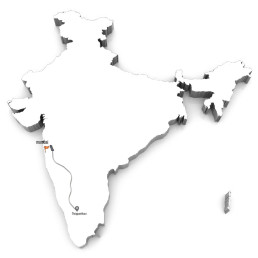
Jnana Yajna 51

Year & Dates:
December 28, 1958 to January 17, 1959

Yajna Topic:
Shrimad Bhagavad Gita- Chapter 12

Place:
Mumbai (Bombay), India.
In the fast-paced urban spread of Mumbai, the excitement of Pujya Gurudev’s upcoming Gita Jnana Yajna was initially tinged with some organizational challenges and lurking fears. The logistics of bringing the yajna planning committee together across the city was first overcome. Then arose the concern about a suitable, centrally accessible venue which was resolved – a beautiful pandal stood electrified and decorated as the yajnashala at Shree Niketan grounds, Marine Drive. Finally, the constant doubt in the back of the organizers’ heads if the attendance will be poor especially on the inaugural Sunday evening of December 28, 1958, was answered. People started gathering even an hour before the time of inauguration. So, when Pujya Gurudev entered the yajnashala precisely at 6 pm with the dignitaries, the atmosphere was surcharged with vibrant sanctity.
A Most Dear Devotee Jnani
Shri Tarachand Gupta, a business magnate of Mumbai, in his welcome address, proposed the idea of All India Radio broadcasting Pujya Gurudev’s discourses as a regular feature to reach millions across India. Shri Mangaldas Pakwasa, chairman of the yajna committee and a respected leader of Mumbai, inaugurated the Jnana Yajna recommending that the Bhagavad Gita should be central in every human’s life.
Then, the first sonorous Om uttered by Pujya Gurudev silenced all clamoring thoughts in the audience – the Chinmaya magic had unfolded yet again. The audience was in rapt attention; the crowds increased as the two hours every evening until January 19th became a time to marvel, assimilate, and meditate. Once Pujya Gurudev had established the important place of Chapter 12, Bhakti Yoga, as the door to the final six chapters of the Gita, He made hearts expand with the ideals that endear one to Bhagavan Krishna. To be in the rarefied heights of egoless and contented compassion, unagitated by the world and its wants, unsawed by extremes in the body, mind, and intellect – the vision of that unstinting devotion that Pujya Gurudev instilled day after day was overwhelming and inspiring.
The final day of the Gita Jnana Yajna, 19th January, when Pujya Gurudev walked among the devotees making sure that at least a few sprinkles of the sacred Ganga-jala touched each one, it was a symbolic culmination. Devotion had to nourish what He called “inward blossoming.” Looking at the spread of the different texts He taught in the first 108 Jnana yajnas, it is no surprise that Pujya Gurudev focused on Chapter 12 as much as the second chapter – about 15 times in the first 108 yajnas where He watered the Vedantic renaissance with the life-giving waters of devotion.
Photo Gallery

“Think,” Says Pujya Gurudev
The mind generally takes the form of the object it contemplates. When an integrated mind-intellect-equipment of a devotee, through constant practice, gains a capacity of entirely engaging itself with the concept of the Lord, to the exclusion of all other agitations and undivine thoughts, the entire finite mind comes to assume the stature of the Infinite.It is the mind that gives us the hallucinations of our ego-centric limitations, and again, it is the mind that rediscovers the Infinite. Bondage and liberation are both for the mind. The Self is ever free; ever liberated; never bound.
From Shrimad Bhagavad Gita- Chapter 12, Book
How to deal with insults?
Learn the essential principles of maintaining a peaceful mind and intellect for effective contemplation. Explore practical strategies for navigating life’s ups and downs with equanimity, leading to special gifts of spiritual insights and personal growth.
Jnana Yajna 50

Jnana Yajna 50

Year & Dates:
December 07, 1958 to December 26, 1958

Yajna Topic:
Atma Bodha

Place:
Thrippunithura, India.
“From the garden of the Upanishads, strung together on the chord of His poetry, interspersed with his exquisite similes, the wonderful garland offered by Adi Shankara to adorn Mother Shruti is Atma Bodha.” This is how Pujya Gurudev introduced the beautiful ‘Prakarana Grantha,’ the prefatory textbook which explains the different terms and terminologies of Vedanta.
Pujya Gurudev began 1958 with a Jnana Yajna on Atma Bodha in Calcutta. He ended 1958 with Atma Bodha again in the 50th Jnana Yajna in the southern town of Thrippunithura in Kerala. Once the capital of the erstwhile Kingdom of Cochin (Kochi), Thrippunithura is a cultural, historic hub. Home of the almost 5000-year-old Poornathrayeesha temple where Bhagavan Vishnu, the presiding deity of the city, is worshiped as Santanagopala Murthy, Thrippunithura was known as Poornavedapuram in the past.
Poetic, Self-Shining Vedanta
The location was holy, and the seekers were ready. Pujya Gurudev had been teaching Atma Bodha in His morning classes all over India, and He decided that it would be the focus of the 50th Jnana Yajna in the evenings from 5:30 pm to 7 pm. The aspirants of Thiruppunithura were truly blessed to hear the enriching analogies in the sixty-eight verse text of Atma Bodha along with Pujya Gurudev’s lucid explanations during the mornings on another Prakarana Grantha – the sparkling Vivekachoodamani.
With His poetic and Vedantic prowess, Pujya Gurudev portrayed the beauty of Self-Knowledge. The examples tucked in every verse so skillfully by the Vedantic Master, Shri Adi Sankara, took vivid shape in the seekers’ minds. To visualize the Self like the lustrous Sun emerging from the clouds, the false glitz of the world like the glint of a mother-of-pearl, and to recognize the individual self conditioned like a crystal upon a blue cloth – Pujya Gurudev made the attentive audience soar to the heights of reflection. In the morning discourses, He emphasized the importance of the four-fold qualifications of seekers (sadhana chatushtaya).
Always fortifying knowledge with devotion, Pujya Gurudev arranged for the unique Vishnu Sahasranama Laksharchana at Thrippunithura on December 14th as the audience from the Ernakulam yajna joined in the collective worship. For the Avabhrta snaana after the kirtan and havana, Pujya Gurudev led all to the serene beach of Kovalam (near Thiruvananthapuram). The calm beach overseeing the endless waves and the expansive blue sky provided the perfect environment for the people to introspect on Atma Bodha. The 50th Jnana Yajna of Pujya Gurudev was pure immersion into the brilliant basics of Vedanta.

“Think,” Says Pujya Gurudev
An individual—who has thus (a) weakened his wrong tendencies through Tapas, (b) who has consequently found in himself a relatively greater mental calmness, (c) in whom the desire-agitations are temporarily at rest,—if he be, (d) one who is a sincere seeker wanting to liberate himself from his known personality shackles, felt in his own within, he is the one who is fit for the study of the Atma-Bodha.
From Atma Bodha, Book
The example here (verse. 22) is of an image of the moon reflected in a bucket of water which seems to shiver when the water surface is disturbed. When the water calms down and becomes steady, we do not see the shattered moon in the bucket-of-water re-assembling to form one whole. Similarly, when one has purified one’s mind and has consolidated its strength and has reconstructed it to be firm and steady by narrowing down its various unholy, unhelpful and selfish thoughts, the glory of the Self gets automatically reflected in all its beauty within oneself—unshaken by the dualities around and the consequent agitations.
From Atma Bodha, Book
What is the use of Spiritual Practices?
In this enlightening discussion, Pujya Gurudev Swami Chinmayananda utilizes the analogy of cooking rice to shed light on the process of spiritual evolution. By exploring the elements of Sadhana – Karma, Bhakti, and Jnana – discover how they harmonize to cultivate the mind for enlightenment. Explore the transformative power of direct knowledge in realizing the true nature of existence.
Jnana Yajna 49

Jnana Yajna 49

Year & Dates:
December 07, 1958 to December 26, 1958

Yajna Topic:
Shrimad Bhagavad Gita- Chapter 5 & 6

Place:
Ernakulam, India.
The young children of Chinmaya Mission, Ernakulam, stood in two neat rows welcoming, with their lighted lamps; and when Pujya Gurudev walked amidst them, their sweet faces glowed even more. In the Durbar Hall grounds, where the Rajas of Kochi used to conduct their royal courts, the 49th Jnana Yajna was inaugurated by the Minister for Law (Kerala), Mr. Krishna Iyer, on the evening of December 7, 1958. After the minister spoke about the need for peace, liberty, and sarvodaya (the social and economic upliftment for all), Pujya Gurudev first pointed out that all the three could be achieved when the spiritual entity within each person is awakened.
The wakeup call is the immortal Shrimad Bhagavad Gita – Pujya Gurudev reminded that “its greatness lies not because it was sung by Lord Krishna, nor because it was written by a great Saint Vyasa, but because of the simple fact that it teaches man of the work-a-day world to live happily and intelligently.”
Joy-giving Renunciation
Pujya Gurudev Swami Chinmayananda was never tired of declaring Gita’s universal, timeless applicability. During that Gita Jnana Yajna too, every evening from 7:30 pm to 9 pm, He explained how selfless action precedes renunciation of action as said by Bhagavan Krishna in the verses of Chapter 5. He detailed the preparatory process for meditation as laid out in chapter 6. When He dramatized the process of focusing one’s gaze between the brows, the audience laughed heartily. When He made them experience the power of quieting their bodies, minds, and intellects in the hush of meditation, they were astounded.
The 49th Yajna was conducted during the same days as the 50th Yajna in the nearby town of Thrippunithura. He taught Vivekachoodamani during the mornings from 7:30 am to 8:30 am and His discourses on Gita from 7:30 pm to 9 pm took place at Ernakulam after He completed the Atma Bodha discourses earlier that evening at Thrippunithura. The ease with which He switched from text to text astonished both the scholar and the novice in the crowds that moved from yajnashala to yajnashala with Him.
The audience of both towns participated in a divinely invigorating Vishnu Sahasranama Laksharchana that was held in Tripunithura on December 14th. It was the first Jnana Yajna where the sacred Vishnu Sahasranama (the thousand names of Bhagavan Vishnu) was chanted all day by devotees while ardent puja was offered extolling His infinite attributes.
The 49th yajna concluded after the Akhanda Kirtan, the Gita Havan, and the Avabhrta snaana at the Kovalam beach near Trivandrum. When the children of the mission presented a program of entertainment on the eve of December 26th, Pujya Gurudev was delighted. The hearts of the seekers of Ernakulam were left to meditate on the selfless joy and knowledge taught by a supreme renunciate.
Photo Gallery

“Think,” Says Pujya Gurudev
If comparison and contrast are the methods ‘of knowing’ for the mind-and-intellect instrument, then to renounce them is to renounce the vehicle. A car is a vehicle that moves on earth. It cannot be used in water. Thus, if I am sailing on the ocean, certainly I am not moving in the car, but I am using a vehicle that can float on the waters. In the field of plurality where compassion and contrast are possible I can use a vehicle of the intellect-and-mind. The stanza here states that he is a true Sanyasi who has gone beyond the perception of contrast, which necessarily means that he is one who has transcended the inner instrument of mind-and-intellect.
From Tyagi Magazine
A meditator invariably finds it difficult to scale into the higher realms of experience due to a sheer psychological fear-complex. As the Yogin slowly and steadily gets himself unwound from his sensuous vasanas, he gets himself released, as it were, from the cruel embrace of his own mental octopus. At this moment of transcendence the unprepared seeker feels himself mortally afraid of the thought that he is getting himself dissolved away into ’nothingness’. The ego, in its long habits of living in close proximity with its own limitations, finds it hard even to believe that there is an existence Supreme, Divine and Infinite. One is reminded of the story of the stranded fisher-women who complained that they could not get any sleep at all that day when they had to spend the night in a perfumery-shop, till they put their baskets very near their nose! Away from our pains we dread to enter Infinite Bliss!
From Tyagi Magazine
Hammer it in!
How do the repeated teachings of ancient wisdom work to dispel misconceptions and introduce profound knowledge? Can we uncover the transformative journey from misconception to enlightenment through these teachings? And how do the paths of Sankhya and Karma Yoga converge to guide seekers towards a higher state of consciousness and understanding? Join us as we explore these questions and delve into the timeless wisdom of the ages.

